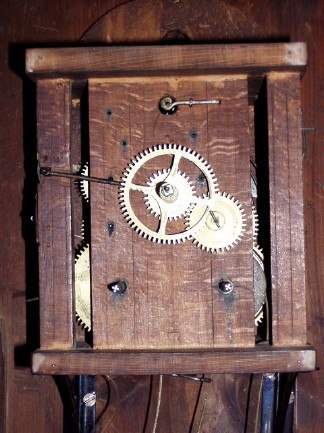|
Early Mechanical ClocksWithout the early mechanical clocks, and their eventual improvements, how would we be answering the following questions today? What time does the meeting start? What time should we come over for dinner? When does the movie start? How much time should we allow to pass through security before our flight leaves? Modern life is controlled by punctuality, being to the designated place on time. Of course, life wasn’t always this hectic and vast numbers of humans today still live their lives in harmony with the natural clock of the solar system. We owe much of our current lifestyle that is governed by precise time to the early mechanical clocks that regulated the lives of monks in the fourteenth century.
Monastic InfluencesFrom earliest times the monastic life was an orderly one, with time intervals set aside for work, meals, sleep, and, of course, daily prayers. Sundials, water clocks or burning candles were used to keep track of time and the bell ringer had the responsibility of regulating the monks’ daily routine. It was the bell ringer’s job to accurately keep track of time. During these early centuries, monks and townspeople were content to divide a day into 12 hours of daylight and 12 hours of nighttime based upon the sun. Since the amount of daylight varies with the seasons, dividing daylight into 12 equal units made the length of an hour also vary with the seasons. When the first mechanical clocks were built in the fourteenth century, the idea of 24 fixed length hours became the norm in Europe. While the first mechanical clocks were used in the monasteries, as European towns expanded in the fourteenth and fifteenth centuries, civil governments wanted their own clocks to regulate life in the towns. The earliest clocks were built into turrets in the local churches or in specially constructed bell towers. Rather than keeping time with hands on a dial, many of these early clocks employed a hammer mechanism that struck the bell to announce the hour.
Eliminating the Human Timekeeper
These early mechanical clocks are some of the first devices to directly replicate human effort with a machine. This explains why many of the old European town clocks feature a carved man, called the clock jack, who comes out of his house and strikes the clock bell. This once was a real job, being the town bell ringer. One ledger record dated 1286 indicates that the bell ringer at St. Paul’s cathedral in London was given a loaf of bread every day. But a rural English town’s records dating from 1410 indicated that the town council was unhappy with their bell ringer and voted to order a town clock that didn’t need a human operator. The oldest known mechanical clock of this era can be found in Salisbury Cathedral in England, which was made in 1386 to strike the hour on the church bell. It wasn’t until the 1930’s that anyone realized the age and importance of this ancient timepiece. In 1956 it was restored to its original design using reproductions of the verge and foliot escapement to replace the pendulum that was added in later centuries. Another similar early mechanical clock is located in the church in Wells, England which features a wooden clock jack who strikes the hour with a hammer and the quarter hour with his heels. The Wells clock also displays fighting knights on the hour. It is likely that these clocks were built at the request of Bishop Erghum who was bishop at Salisbury from 1375 to 1388 and bishop at Wells from 1388 until 1400.
The Clock Mechanism
Remember that these early mechanical clocks did not need to move hands on dial; these clocks just rang the bell the correct number of times at fixed intervals. Since the mechanical clock was automating the task of a human bell ringer, it’s helpful to visualize a back-and-forth motion associated with striking a bell. This principle of back-and-forth motion is at the heart of the early mechanical clocks, technically called the crown-verge escapement. The crown-verge escapement features the foliot which is a pivoting beam (lever arm) with a moveable weight at each end. As this weighted beam oscillates, it drives a series of gear wheels at a relatively constant rate. The last gear is called the crown wheel because its shape resembles a crown. The pointed tips of the crown wheel are blocked and released by pallets on the gear axle which are called the verge. These blocking and releasing functions of the verge control the oscillations of the lever arm or foliot. The crown gear is also called the escape wheel because this gear allows the rotating motion of the gear train to click over or escape one tooth at a time. The length of the foliot and the position of the moveable weights on the foliot combine to control the rate at which teeth on the crown wheel escape and regulate the length of time before the bells strike again. While these early mechanical clocks were not particularly accurate and required constant maintenance, they did introduce uniformity to life for townspeople throughout Europe. Need more information?
You can obtain early mechanical clocks on Ebay. They always have a large collection available. New to eBay? It's easy to register and only takes a few minutes.
|




